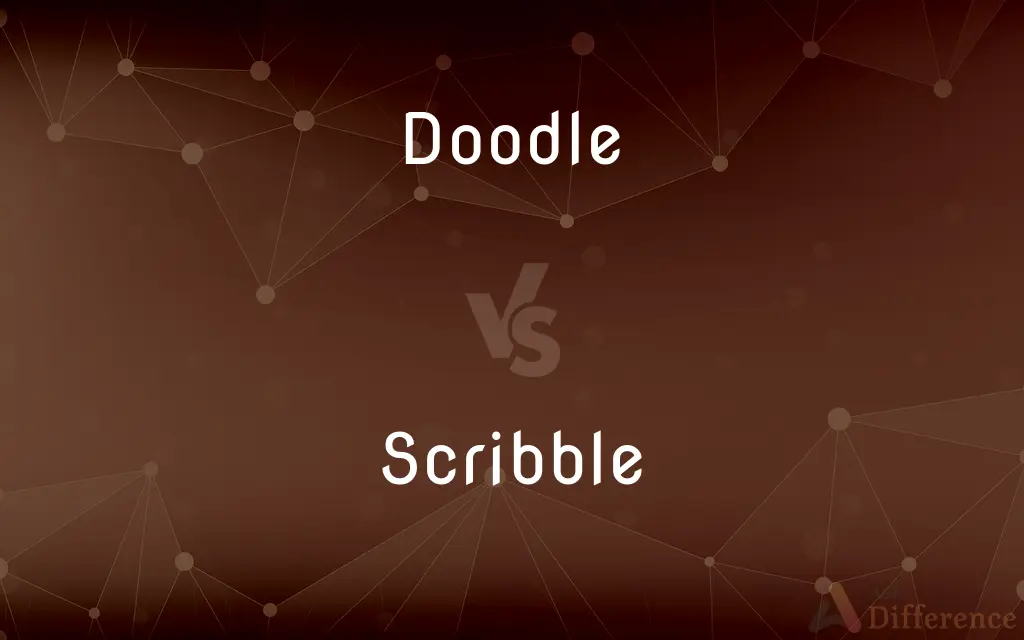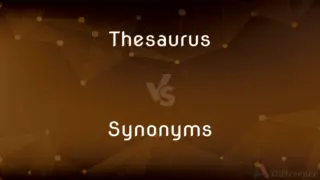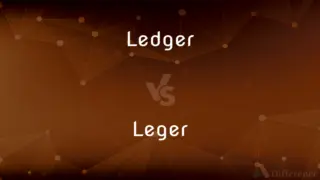Doodle vs. Scribble — What's the Difference?
By Tayyaba Rehman & Urooj Arif — Updated on March 22, 2024
Doodles are simple drawings with concrete or abstract meanings, often created subconsciously. Scribbles are random, aimless marks made without any attempt at visual representation.

Difference Between Doodle and Scribble
Table of Contents
ADVERTISEMENT
Key Differences
Doodles often emerge from someone's subconscious mind while they are distracted or thinking about something else. These drawings can range from abstract patterns to recognizable shapes and figures, sometimes revealing insights into the doodler's thoughts or feelings. In contrast, scribbles are usually made without any deliberate focus or intention, often by young children as they learn to control a writing instrument. Scribbles do not aim to represent anything specific and are characterized by their lack of form and structure.
Doodles can be reflective of a person's mood, interests, or state of mind at the time of doodling. People often doodle when they are bored, anxious, or thinking deeply, using repetitive patterns or familiar shapes. Scribbles, however, are more about the act of movement and the sensory experience of making marks, without any concern for the outcome or appearance of these marks.
The context in which doodles and scribbles are made also differs. Doodles are often found in the margins of notebooks, on scraps of paper, or during meetings and phone calls—anywhere a person's mind might wander. Scribbles might be found in similar settings but are more commonly associated with the early stages of a child's motor skill development, appearing on any surface they can draw on, including walls, furniture, and books.
Doodling has been studied for its potential cognitive benefits, including aiding concentration, memory retention, and processing emotions. It can also be a form of artistic expression, with some doodles evolving into more elaborate sketches or artworks. Scribbling, while not typically regarded as art, is crucial in the development of fine motor skills and visual literacy in children, laying the groundwork for more purposeful drawing and writing.
Comparison Chart
Definition
Simple drawings with meaning
Aimless, random marks
ADVERTISEMENT
Intention
Subconscious expression
Lack of deliberate intention
Representation
Can be abstract or concrete
Does not represent anything
Purpose
Expression, creativity
Motor skill development, stress relief
Cognitive Benefits
Aids concentration, memory
Develops fine motor skills
Audience
All ages
Primarily young children
Common Contexts
Margins of notes, during meetings
Early childhood development
Outcome
Reflective of mood or thoughts
Non-specific
Artistic Value
Potential for artistic expression
Generally not considered art
Compare with Definitions
Doodle
Creative expression.
Doodling can turn into an elaborate sketch, showcasing artistic talent.
Scribble
Lack of deliberate intention.
Scribbling can be a stress-relieving activity, without aiming to create anything specific.
Doodle
Subconscious drawings.
Doodling a series of stars while daydreaming reflects subconscious thought.
Scribble
Developmental tool for children.
Scribbling is a crucial step in developing fine motor skills and coordination.
Doodle
Varied in meaning.
A doodle can represent a person's mood, from happy faces to abstract patterns.
Scribble
Not aimed to represent anything.
A child’s scribbles are exploratory, not meant to depict real objects.
Doodle
Cognitive benefits.
Doodling during a lecture can help retain information better.
Scribble
Random marks.
Scribbles on a paper might show a child's early attempts at using a crayon.
Doodle
Found in many contexts.
Margins of a notebook are often filled with doodles during a boring meeting.
Scribble
Can be found on various surfaces.
A child might scribble on walls, experimenting with their ability to mark surfaces.
Doodle
Make a doodle; draw aimlessly
Scribble
To write (a note, for example) hurriedly without heed to legibility or style.
Doodle
A doodle is a drawing made while a person's attention is otherwise occupied. Doodles are simple drawings that can have concrete representational meaning or may just be composed of random and abstract lines, generally without ever lifting the drawing device from the paper, in which case it is usually called a "scribble".
Scribble
To draw (a picture) hurriedly or carelessly.
Doodle
Scribble absent-mindedly
He was only doodling in the margin
Scribble
To write in a hurried careless way.
Doodle
A rough drawing made absent-mindedly
The text was interspersed with doodles
Scribble
To make meaningless marks, as with a pen or pencil.
Doodle
To draw or sketch aimlessly, especially when preoccupied.
Scribble
Careless hurried writing.
Doodle
To draw (figures) while preoccupied.
Scribble
Meaningless marks and lines.
Doodle
A figure or design drawn or written absent-mindedly.
Scribble
(ambitransitive) To write or draw carelessly and in a hurry.
I suddenly remembered I needed to buy bleach, so scribbled it down on my shopping list.
Doodle
(obsolete) A fool, a simpleton, a mindless person.
Scribble
To doodle.
Doodle
A small mindless sketch, etc.
Scribble
To write badly; to work as an inferior author or journalist.
Doodle
Any crossbreed of a poodle with a different breed of dog.
Scribble
To card or tease (wool) coarsely; to run through a scribbler.
Doodle
(ambitransitive) To draw or scribble aimlessly.
The bored student doodled a submarine in his notebook.
Scribble
Careless, hasty writing, doodle or drawing
Doodle
(Scotland) To drone like a bagpipe.
Scribble
To card coarsely; to run through the scribbling machine.
Doodle
A trifler; a simple fellow.
Scribble
To write hastily or carelessly, without regard to correctness or elegance; as, to scribble a letter.
Doodle
An aimless drawing
Scribble
To fill or cover with careless or worthless writing.
Scribble
To write without care, elegance, or value; to scrawl.
If Mævius scribble in Apollo's spite.
Scribble
Hasty or careless writing; a writing of little value; a scrawl; as, a hasty scribble.
Neither did I but vacant seasons spendIn this my scribble.
Scribble
Poor handwriting
Scribble
An aimless drawing
Scribble
Write down quickly without much attention to detail
Scribble
Write carelessly
Common Curiosities
What is a scribble?
A scribble is a random, aimless mark made without any attempt at visual representation.
Are doodles considered art?
Some doodles can evolve into artistic sketches and are considered a form of creative expression.
Do scribbles have any meaning?
Scribbles usually do not have a deliberate meaning; they are exploratory marks made by children.
What is a doodle?
A doodle is a simple, subconscious or spontaneous drawing, which can have abstract or concrete meanings.
Why do children scribble?
Scribbling is a developmental activity that helps children develop fine motor skills and hand-eye coordination.
How do doodles differ from scribbles?
Doodles may carry subconscious meanings or be more intentional, while scribbles are aimless and random.
Why do people doodle when bored?
Doodling can help keep the brain engaged and process thoughts during periods of boredom or inattention.
Are scribbles a form of art?
While generally not considered art, scribbles are important for developmental creativity in children.
Can doodling have benefits?
Yes, doodling can aid in concentration, memory retention, and emotional processing.
Is scribbling important for children?
Yes, it's a vital step in their motor and cognitive development.
Can you learn about a person through their doodles?
Doodles can sometimes reflect a person’s mood, interests, or subconscious thoughts.
What materials are commonly used for doodling and scribbling?
Pens, pencils, crayons, and markers on paper, but any surface can be used, especially by children scribbling.
How do cultural perceptions of doodling and scribbling differ?
Doodling is often seen as a creative or productive activity, while scribbling is viewed as a developmental stage in children, with less focus on elders.
Can doodling improve focus?
Yes, studies suggest that doodling can help some individuals maintain focus and retain information better.
Share Your Discovery

Previous Comparison
Thesaurus vs. Synonyms
Next Comparison
Ledger vs. LegerAuthor Spotlight
Written by
Tayyaba RehmanTayyaba Rehman is a distinguished writer, currently serving as a primary contributor to askdifference.com. As a researcher in semantics and etymology, Tayyaba's passion for the complexity of languages and their distinctions has found a perfect home on the platform. Tayyaba delves into the intricacies of language, distinguishing between commonly confused words and phrases, thereby providing clarity for readers worldwide.
Co-written by
Urooj ArifUrooj is a skilled content writer at Ask Difference, known for her exceptional ability to simplify complex topics into engaging and informative content. With a passion for research and a flair for clear, concise writing, she consistently delivers articles that resonate with our diverse audience.
















































